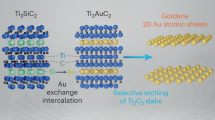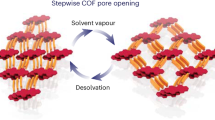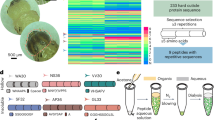Abstract
Progress in nanocrystal synthesis and self-assembly enables the formation of highly ordered superlattices. Recent studies focused on spherical particles with tunable attraction and polyhedral particles with anisotropic shape, and excluded volume repulsion, but the effects of shape on particle interaction are only starting to be exploited. Here we present a joint experimental–computational multiscale investigation of a class of highly faceted planar lanthanide fluoride nanocrystals (nanoplates, nanoplatelets). The nanoplates self-assemble into long-range ordered tilings at the liquid–air interface formed by a hexane wetting layer. Using Monte Carlo simulation, we demonstrate that their assembly can be understood from maximization of packing density only in a first approximation. Explaining the full phase behaviour requires an understanding of nanoplate-edge interactions, which originate from the atomic structure, as confirmed by density functional theory calculations. Despite the apparent simplicity in particle geometry, the combination of shape-induced entropic and edge-specific energetic effects directs the formation and stabilization of unconventional long-range ordered assemblies not attainable otherwise.
This is a preview of subscription content, access via your institution
Access options
Subscribe to this journal
Receive 12 print issues and online access
$259.00 per year
only $21.58 per issue
Buy this article
- Purchase on Springer Link
- Instant access to full article PDF
Prices may be subject to local taxes which are calculated during checkout





Similar content being viewed by others
References
Glotzer, S. C. & Solomon, M. J. Anisotropy of building blocks and their assembly into complex structures. Nature Mater. 6, 557–562 (2007).
Jones, M. R. et al. DNA-nanoparticle superlattices formed from anisotropic building blocks. Nature Mater. 9, 913–917 (2010).
Li, F., Josephson, D. P. & Stein, A. Colloidal assembly: the road from particles to colloidal molecules and crystals. Angew. Chem. Int. Ed. 50, 360–388 (2011).
Ye, X. et al. Morphologically controlled synthesis of colloidal upconversion nanophosphors and their shape-directed self-assembly. Proc. Natl Acad. Sci. USA 107, 22430–22435 (2010).
Langille, M. R., Zhang, J., Personick, M. L., Li, S. & Mirkin, C. A. Stepwise evolution of spherical seeds into 20-fold twinned icosahedra. Science 337, 954–957 (2012).
Zhang, Y. W., Sun, X., Si, R., You, L. P. & Yan, C. H. Single-crystalline and monodisperse LaF3 triangular nanoplates from a single-source precursor. J. Am. Chem. Soc. 127, 3260–3261 (2005).
Saunders, A. E., Ghezelbash, A., Smilgies, D. M., Sigman, M. B. & Korgel, B. A. Columnar self-assembly of colloidal nanodisks. Nano Lett. 6, 2959–2963 (2006).
Shevchenko, E. V., Talapin, D. V., Kotov, N. A., O'Brien, S. & Murray, C. B. Structural diversity in binary nanoparticle superlattices. Nature 439, 55–59 (2006).
Leunissen, M. E. et al. Ionic colloidal crystals of oppositely charged particles. Nature 437, 235–240 (2005).
Yethiraj, A. & Van Blaaderen, A. A colloidal model system with an interaction tunable from hard sphere to soft and dipolar. Nature 421, 513–517 (2003).
Chen, Q., Bae, S. C. & Granick, S. Directed self-assembly of a colloidal kagome lattice. Nature 469, 381–384 (2011).
Macfarlane, R. J. et al. Nanoparticle superlattice engineering with DNA. Science 334, 204–208 (2011).
Bishop, K. J. M., Wilmer, C. E., Soh, S. & Grzybowski, B. A. Nanoscale forces and their uses in self-assembly. Small 5, 1600–1630 (2009).
Zhao, K., Bruinsma, R. & Mason, T. G. Entropic crystal–crystal transitions of Brownian squares. Proc. Natl Acad. Sci. USA 108, 2684–2687 (2011).
Haji-Akbari, A. et al. Disordered, quasicrystalline and crystalline phases of densely packed tetrahedra. Nature 462, 773–777 (2009).
Damasceno, P. F., Engel, M. & Glotzer, S. C. Crystalline assemblies and densest packings of a family of truncated tetrahedra and the role of directional entropic forces. ACS Nano 6, 609–614 (2012).
Agarwal, U. & Escobedo, F. A. Mesophase behaviour of polyhedral particles. Nature Mater. 10, 230–235 (2011).
Miszta, K. et al. Hierarchical self-assembly of suspended branched colloidal nanocrystals into superlattice structures. Nature Mater. 10, 872–876 (2011).
Henzie, J., Grünwald, M., Widmer-Cooper, A., Geissler, P. L. & Yang, P. Self-assembly of uniform polyhedral silver nanocrystals into densest packings and exotic superlattices. Nature Mater. 11, 131–137 (2011).
Bodnarchuk, M. I., Kovalenko, M. V., Heiss, W. & Talapin, D. V. Energetic and entropic contributions to self-assembly of binary nanocrystal superlattices: temperature as the structure-directing factor. J. Am. Chem. Soc. 132, 11967–11977 (2010).
Evers, W. H. et al. Entropy-driven formation of binary semiconductor–nanocrystal superlattices. Nano Lett. 10, 4235–4241 (2010).
Chen, Z., Moore, J., Radtke, G., Sirringhaus, H. & O'Brien, S. Binary nanoparticle superlattices in the semiconductor–semiconductor system: CdTe and CdSe. J. Am. Chem. Soc. 129, 15702–15709 (2007).
Chen, Z. & O'Brien, S. Structure direction of II–VI semiconductor quantum dot binary nanoparticle superlattices by tuning radius ratio. ACS Nano 2, 1219–1229 (2008).
Dong, A., Ye, X., Chen, J. & Murray, C. B. Two-dimensional binary and ternary nanocrystal superlattices: the case of monolayers and bilayers. Nano Lett. 11, 1804–1809 (2011).
Damasceno, P. F., Engel, M. & Glotzer, S. C. Predictive self-assembly of polyhedra into complex structures. Science 337, 453–457 (2012).
Jones, M. R., Macfarlane, R. J., Prigodich, A. E., Patel, P. C. & Mirkin, C. A. Nanoparticle shape anisotropy dictates the collective behavior of surface-bound ligands. J. Am. Chem. Soc. 133, 18865–18869 (2011).
Glotzer, S. C. Nanotechnology: shape matters. Nature 481, 450–452 (2012).
Bealing, C. R., Baumgardner, W. J., Choi, J. J., Hanrath, T. & Hennig, R. G. Predicting nanocrystal shape through consideration of surface–ligand interactions. ACS Nano 6, 2118–2127 (2012).
Blunt, M. O. et al. Random tiling and topological defects in a two-dimensional molecular network. Science 322, 1077–1081 (2008).
Stannard, A. et al. Broken symmetry and the variation of critical properties in the phase behaviour of supramolecular rhombus tilings. Nature Chem. 4, 112–117 (2012).
Whitelam, S., Tamblyn, I., Beton, P. & Garrahan, J. Random and ordered phases of off-lattice rhombus tiles. Phys. Rev. Lett. 108, 1–4 (2012).
Wang, F. et al. Simultaneous phase and size control of upconversion nanocrystals through lanthanide doping. Nature 463, 1061–1065 (2010).
Zhao, K. & Mason, T. G. Twinning of rhombic colloidal crystals. J. Am. Chem. Soc. 134, 18125–18131 (2012).
Zalkin, A. & Templeton, D. The crystal structures of YF3 and related compounds. J. Am. Chem. Soc. 75, 2453–2458 (1953).
Dong, A., Chen, J., Vora, P. M., Kikkawa, J. M. & Murray, C. B. Binary nanocrystal superlattice membranes self-assembled at the liquid–air interface. Nature 466, 474–477 (2010).
Van der Kooij F. M., Kassapidou, K. & Lekkerkerker, H. M. W. Liquid crystal phase transitions in suspensions of polydisperse plate-like particles. Nature 406, 868–871 (2000).
Paik, T., Ko, D-K., Gordon, T. R., Doan-Nguyen, V. & Murray, C. B. Studies of liquid crystalline self-assembly of GdF3 nanoplates by in-plane, out-of-plane SAXS. ACS Nano 5, 8322–8230 (2011).
Stannard, A., Blunt, M. O., Beton, P. H. & Garrahan, J. P. Entropically stabilized growth of a two-dimensional random tiling. Phys. Rev. E 82, 041109 (2010).
Roke, S., Berg, O., Buitenhuis, J., Van Blaaderen, A. & Bonn, M. Surface molecular view of colloidal gelation. Proc. Natl Acad. Sci. USA 103, 13310–13314 (2006).
Kresse, G. & Furthmüller, J. Efficient iterative schemes for ab initio total-energy calculations using a plane-wave basis. Phys. Rev. B 54, 11169–11186 (1996).
Acknowledgements
X.Y. and C.B.M. acknowledge support from the Office of Naval Research Multidisciplinary University Research Initiative on Optical Metamaterials through award N00014-10-1-0942. J.C. acknowledges support from the Materials Research Science and Engineering Center program of the National Science Foundation (NSF) under award DMR-1120901. C.B.M. is also grateful to the Richard Perry University Professorship for support of his supervisor role. M.E., J.A.M. and S.C.G. acknowledge support by the Assistant Secretary of Defense for Research and Engineering, US Department of Defense (N00244-09-1-0062). Any opinions, findings, and conclusions or recommendations expressed in this publication are those of the authors and do not necessarily reflect the views of the DOD/ASD (R&E). W.L., L.Q. and J.L. acknowledge support from the NSF (DMR-1120901). G.X. and C.R.K. acknowledge support from the US Department of Energy, Office of Basic Energy Sciences, Division of Materials Sciences and Engineering (Award DE-SC0002158). Correspondence and requests for materials should be addressed to S.C.G. and C.B.M.
Author information
Authors and Affiliations
Contributions
X.Y. and J.E.C. carried out nanocrystal syntheses. X.Y. and J.C. performed nanocrystal self-assembly and structural characterization. M.E. conceived the Monte Carlo simulations. J.A.M. performed and analysed the Monte Carlo simulations. W.L. and L.Q. performed DFT calculations. G.X. conducted atomic force microscopy (AFM) characterization. S.C.G. and C.B.M. designed the study and supervised the project. All authors discussed the results and co-wrote the manuscript.
Corresponding authors
Ethics declarations
Competing interests
The authors declare no competing financial interests.
Supplementary information
Supplementary information
Supplementary information (PDF 9232 kb)
Supplementary information
Supplementary Movie 1 (MP4 4839 kb)
Supplementary information
Supplementary Movie 2 (MP4 4839 kb)
Supplementary information
Supplementary Movie 3 (MP4 4505 kb)
Supplementary information
Supplementary Movie 4 (MP4 4738 kb)
Supplementary information
Supplementary Movie 5 (MP4 6212 kb)
Supplementary information
Supplementary Movie 6 (MP4 4508 kb)
Rights and permissions
About this article
Cite this article
Ye, X., Chen, J., Engel, M. et al. Competition of shape and interaction patchiness for self-assembling nanoplates. Nature Chem 5, 466–473 (2013). https://doi.org/10.1038/nchem.1651
Received:
Accepted:
Published:
Issue Date:
DOI: https://doi.org/10.1038/nchem.1651
This article is cited by
-
Entropy compartmentalization stabilizes open host–guest colloidal clathrates
Nature Chemistry (2023)
-
Curvature and self-assembly of semi-conducting nanoplatelets
Communications Chemistry (2022)
-
Assembly of planar chiral superlattices from achiral building blocks
Nature Communications (2022)
-
Structural diversity in three-dimensional self-assembly of nanoplatelets by spherical confinement
Nature Communications (2022)
-
Symmetry-breaking in patch formation on triangular gold nanoparticles by asymmetric polymer grafting
Nature Communications (2022)



